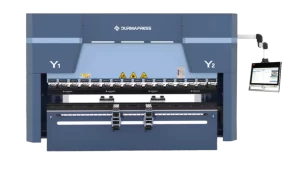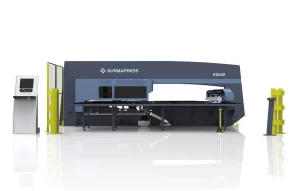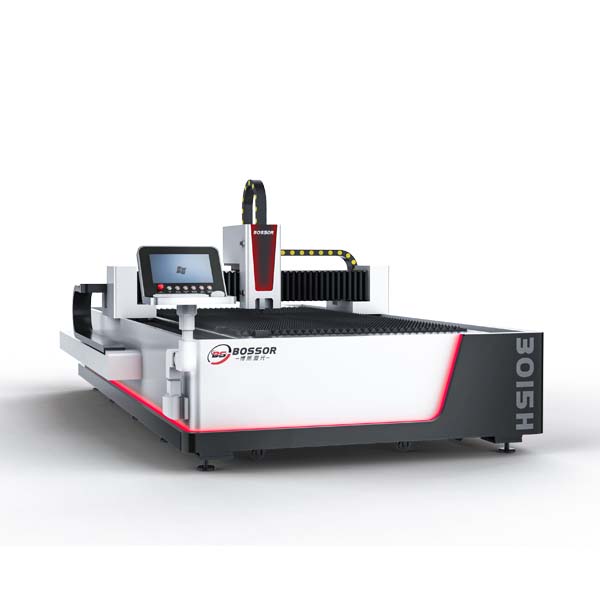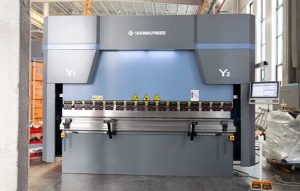
О нас
Durmapress specializes in designing, manufacturing, and selling various metal processing equipment, including bending machines, shears, punches, and laser cutting machines. The company was founded in 2014, with years of experience and technology accumulation. DurmaPress has become one of the well-known brands in China's metal processing machinery industry.
Свяжитесь с нами
Последние сообщения
Категории
Следуйте за нами
Еженедельное новое видео
The push toward smart fabrication and automated production has transformed the way factories handle sheet metal bending. As global labor shortages and rising production costs continue to pressure manufacturers, automatic press brakes are becoming essential assets for improving precision, consistency, and throughput.
This 2025 guide explains what an automatic press brake is, how it works, where it is used, and why manufacturers increasingly rely on automation-driven bending solutions.
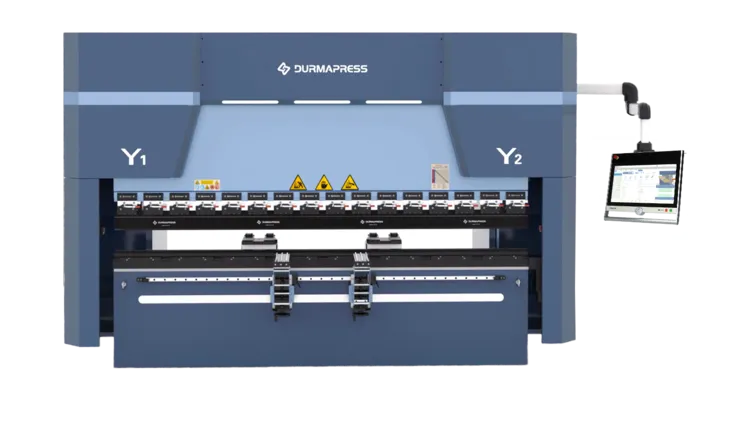
What Is an Automatic Press Brake?
An automatic press brake is an advanced sheet metal bending machine capable of performing programming, positioning, bending, and tool changes with minimal operator intervention. It integrates CNC control, servo-driven systems, robotics, and real-time sensors to automate repetitive bending tasks.
Key Characteristics
- Automated axis control (Y1/Y2, X, R, Z1/Z2)
- Automatic tool clamping or tool changing
- Servo or hybrid hydraulic systems for stable bending
- Real-time angle measurement and compensation
- Safety automation (laser guards, DSP systems)
- Optional robotic bending or sheet followers
Core SEO keywords naturally included: automatic press brake, CNC press brake, automated bending system.
For manufacturers comparing different levels of automation, our CNC Press Brake solutions offer a reliable benchmark in precision and control.
How an Automatic Press Brake Works
At its core, an automatic press brake uses controlled force and precise axis movement to bend sheet metal. What differentiates it is the degree of automation embedded in each stage of the bending cycle.
1. CNC Programming
The operator inputs or imports a 2D/3D bending file into the CNC controller (e.g., Delem, Cybelec, ESA).
The controller automatically calculates:
- Bending sequence
- Tool layout
- Backgauge movement
- Коронование
- Required tonnage
2. Automatic Tool Setup
Modern systems feature:
- Fast clamping systems
- Wila-style hydraulic tool holders
- Automatic tool changers (ATC)
These dramatically reduce setup time for job switches.
3. Backgauge Positioning
Servo-driven X, R, Z axes position the sheet with ±0.01 mm precision.
The machine automatically adjusts gauge fingers for each bend.

4. Bending Execution with Real-Time Feedback
Sensors measure:
- Material thickness
- Springback
- Angle deviation
Systems like laser angle measurement or DSP safety sensors ensure consistent bend quality with automated corrections.
5. Automated Handling (Optional)
For high-volume production, robots or bending followers assist:
- Позиционирование листов
- Rotation
- Stacking
This makes the press brake part of a fully automated fabrication cell.
As automated production becomes the new standard, Sheet Metal Bending Machines continue to evolve toward higher accuracy, lower labor reliance, and fully connected workflows.
Why Automatic Press Brakes Matter in Modern Manufacturing
Automatic press brakes significantly influence efficiency, labor allocation, and product consistency. In competitive industries such as HVAC, automotive, and metal furniture, automation is no longer optional—it’s a strategic advantage.
1. Higher Accuracy and Consistency
Automated crowning, servo precision, and angle-measuring systems help maintain identical bend quality across thousands of pieces.
2. Reduced Labor Dependency
Skilled press brake operators are difficult to recruit and retain.
Automation reduces dependency by enabling:
- fewer operators
- shorter training cycles
- easier job transitions
3. Shorter Setup and Changeover Time
With automatic tool clamping and CNC programming, setup can be reduced by 50–70%, enabling more flexible production.
4. Lower Production Cost
Consistent bending and reduced scrap help companies control cost per part, especially for high-volume jobs.
5. Safer Working Environment
Built-in safety systems—light curtains, DSP lasers, hydraulic overload protection—minimize operator risk.
6. Better Fit for Industry 4.0 Integration
Automatic press brakes can connect to:
- MES systems
- ERP
- Remote monitoring dashboards
These integrations enhance data-driven manufacturing.
Key Features to Look for in an Automatic Press Brake (2025 Updates)
1. CNC Controller
Look for multi-axis support, intuitive interface, and quick auto-programming.
Example: Delem DA-66S, Cybelec CybTouch, ESA S660.

2. Automation Level
From semi-automatic to fully robotic:
- Auto gauging
- Auto tool change
- Auto angle correction
- Robotic integration
3. Drive System
- Hybrid hydraulic – energy efficient, stable
- Full servo-electric – highest precision, low noise
- Conventional hydraulic – cost-effective
Manufacturers seeking higher energy efficiency and faster cycle speeds often upgrade to a Servo Hybrid Press Brake, which integrates servo precision with stable hydraulic power.
4. Bending Accuracy Enhancements
- Laser angle detection
- Dynamic crowning
- Servo control of Y-axis
- Compensated bending algorithms
5. Tooling and Clamping

Wila-style clamping, European tooling, American tooling compatibility.
To achieve consistent angles and avoid rework, selecting high-quality Оснастка для листогибочных прессов is essential, especially for complex profiles or high-strength materials.
6. Safety Systems
- DSP laser protection
- Light curtain
- Automatic safety stop
Applications of Automatic Press Brakes in 2025
Automatic press brakes support industries such as:
- HVAC duct production
- Electrical cabinets
- Automotive panels
- Aerospace brackets
- Metal doors, frames, and furniture
- Precision electronic enclosures
- Custom fabrication workshops
Adaptability makes them essential in factories seeking accuracy and repeatability.
How to Choose the Right Automatic Press Brake (Buyer’s Checklist)
1. Identify Your Production Needs
- What thickness and material do you bend?
- What bend lengths are required?
- Batch volume—high mix or mass production?
2. Choose the Right Tonnage and Length
Typical ranges:
- 40T–200T for light/medium fabrication
- 300T–600T for large parts
- 3–6 meters bending length
3. Automation Requirements
If you switch jobs frequently → choose ATC
If you handle heavy sheets → use bending followers
If you run 24/7 → consider a robotic cell
4. Evaluate Controller & Software
Should support:
- 3D visualization
- Auto bend sequencing
- Tool database
- Offline programming
5. Supplier Reliability
Check whether the supplier offers:
- Installation and training
- Spare parts availability
- Service network
- Global certifications
Why Choose Durmapress for Automatic Press Brakes?
Durmapress has 20+ years of experience manufacturing CNC and automatic press brakes, combining European engineering standards with modern automation technologies.
Our automatic press brake solutions include:
- Multi-axis CNC control
- Servo-hybrid energy-saving systems
- Wila-style clamping
- DSP laser safety
- Advanced crowning
- Optional robotic bending lines
Designed for reliability, precision, and long-term performance.
FAQ: Automatic Press Brakes (2025)
A CNC press brake requires manual setup, while an automatic press brake performs programming, gauging, and tool changes automatically.
Yes. Automatic press brakes reduce labor cost and enable one operator to run multiple machines.
10–20 years depending on maintenance and usage environment.
Yes. Automatic press brakes handle steel, SS, aluminum, and coated metals with high precision.


